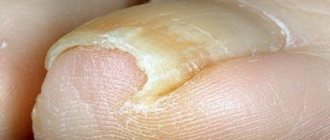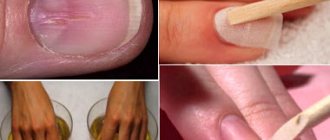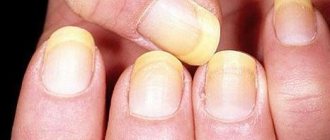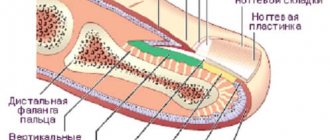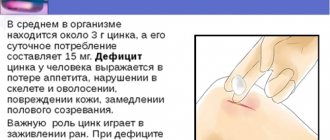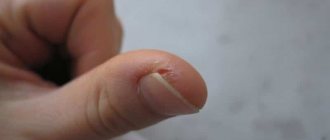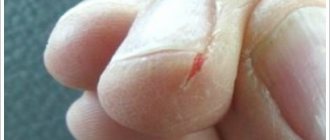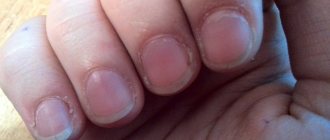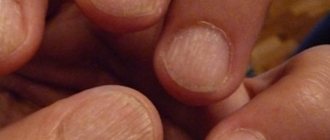What it is?
Onychorrhexis is one of the few types of violation of the integrity of the nails.
As a result of the disease, the surface of the nail plate is split in the longitudinal direction. This visible defect is not an independent pathology, but occurs as a symptom of the underlying disease.
Diagnosis of onychorrhexis is carried out after a series of tests:
- external examination under a magnifying glass;
- scraping from the surface to detect the presence of fungal infections;
- taking blood tests;
- carrying out confocal microscopy.
Additionally, tests such as ultrasound of organs located in the abdominal cavity, thyroid gland, and gastroscopy may be prescribed.
On a note! Onychorrhexis is the term that dermatologists use to describe problems with nails, such as lamination and brittleness.
Photo
Below you can see a photo of the affected nail plates:
Reasons for appearance
The formation of onychorrhexis on the nails can be caused by a number of factors and diseases. They all boil down to a general principle: if microcirculation disturbances occur in the nail growth zone, changes in the composition of the blood, this leads to visible symptoms.
On a note! At the initial stage, onychorrhexis creates a visible cosmetic defect. In its advanced form, nails are also affected by a fungal infection. This leads to complete damage to the nail plate.
Who is at risk for onychorrhexis:
- people with Raynaud's syndrome and other autoimmune diseases;
- suffering from systemic atherosclerosis, eczema, alopecia;
- having nail diseases such as onychomycosis (fungus), psoriasis;
- diagnosed with diabetes mellitus or thyrotoxicosis;
- women who use cheap nail polishes that contain acetone;
- those who often come into contact with aggressive detergents and household chemicals without using hand protection;
- mechanically injured nails;
- having a tendency to this disease, which is inherited.
Sometimes onychorrhexis can occur in people suffering from obsessive-compulsive disorder .
With this disease, a person has the feeling that his hands are dirty, and he washes them every 20-30 minutes. Splitting nails in childhood can occur not only as a result of some disease, but also due to malnutrition, lack of necessary minerals and vitamins in the body.
Important! Onychorrhexis can occur after visiting a manicurist who has injured the matrix of the nail plate.
Causes of deformity in adults
Many people wonder: why does the nail on the little toe bifurcate and look like a second small one? Many factors influence the formation of such a disease.
Fungus
There are over a dozen types of fungus that affect the nail structure. The disease with mycosis begins with a small area, after which the entire nail surface, as well as the surrounding skin, is affected. Externally, it manifests itself as wavy defects in the plate, thickening, yellowing of the nail, changes in shape, fragility, and spots of different colors appear.
Fungus multiplies in a humid environment: on sweaty feet, due to wearing synthetic fabrics and poor-quality shoes. Bacteria are found in public places, so it is recommended to maintain personal hygiene - this will reduce the likelihood of infection.
Injury
The result of a bruise is damage to the soft tissue under the plate. It is necessary to remove the accumulated blood.
Psoriasis
This autoimmune disease affects the skin. External symptoms of the disease can have a detrimental effect on communication with other people. The spots are first visible on the nails. When psoriasis manifests itself, furrows appear on them, the color (from gray to brown) and the structure of the plate change, intense damage to the epithelial cells occurs, stratification occurs, and itching begins.
Psoriasis and fungal disease can look the same, so it is necessary to get tested and diagnosed in order to prescribe the appropriate treatment.
Poor quality shoes
As a result of wearing uncomfortable and narrow shoes, a split nail appears on the toe, which is accompanied by noticeable pain. The nail grows into the skin, and this may require surgical treatment.
Other reasons
Distortion of the appearance of the plate surface occurs as a result of the influence of factors:
- human internal diseases,
- decreased hemoglobin level (pale color),
- medicines,
- heredity,
- infections,
- constituent components of cleaning products (can disrupt the structure of the nail),
- improper processing (improper grinding and trimming, untimely or excessive cleansing, which causes injury to the skin and, as a result, an increase in the number of bacteria affecting the nail),
- oral medications containing vitamin A,
- mental disorders - cause the appearance of a wavy structure of the plate,
- malnutrition, malnutrition,
- cardiac disorders (redness),
- lung problems (yellow surface color),
- diabetes,
- liver and kidney diseases.
Symptoms
It is quite difficult to detect onychorrhexis at an early stage, since the disease develops gradually. The main symptom is longitudinal splitting of the nail on one or more fingers at the same time.
First signs:
- transverse peeling of nails;
- small cracks, one or more, appear on the surface;
- the color of the nail changes, it becomes yellow or gray;
- onychorrhexis first affects one or two fingers located nearby.
If the disease is ignored and not treated, onychorrhexis affects all fingers on both limbs.
In an advanced state, onychorrhexis on the nails can be identified by symptoms such as:
- multiple detachments of the stratum corneum;
- the cracks become deeper, or one longitudinal crack forms;
- the nail breaks;
- redness of the skin occurs on the sides;
- complete destruction of the surface of the nail plate.
If the cause of onychorrhexis is a fungal infection, then other symptoms are added to the main symptoms:
- inflammation;
- edema;
- suppuration;
- unpleasant discomfort when pressing on the nail;
- ingrowth into the skin.
Causes
Many girls believe that a crack in a nail is always the result of a mechanical impact on it, a bruise, or other damage. However, there are a large number of other factors that contribute to the fact that the nail plate gradually becomes thinner and undergoes premature breakage.
This is not the first time a nail has cracked, you need to understand why this is happening. This way you can prevent the formation of new cracks.
External influence
The most common cases of breakage on the nail plate are usually associated with aggressive external influences.
There may be several antecedent factors for this:
- Bruised finger.
- Pinching.
- Working with chemicals and aggressive components without using gloves.
- Hypothermia of the hands or vice versa – overheating in the sun.
- Constant contact with water.
- Sudden change in temperature.
Pay attention to these factors, as girls violate them most often. You should not neglect the use of rubber gloves when working with chemicals (paints, varnishes, detergents) and while walking down the street in the cold season.
Also keep in mind that during a trip to the resorts, the condition of the nails can also deteriorate, so pay attention to the choice of care products - oils, baths, masks, which will further strengthen them and prevent the formation of cracks.
Lack of nutrients
In a normal state, a large amount of microelements and vitamins arrive from the human body to the fingertips, which are redirected to the nails through the matrix. However, problems with hormonal levels or insufficient intake of vitamins in the diet can lead to their deficiency.
With a small supply of useful substances to the structure, they gradually become thinner, which is why cracks can form.
To restore the condition of marigolds, you need to balance your diet and include special supplements in your diet, which contain calcium, iron and other trace elements.
Nail diseases
When fungus forms on the surface, the condition of the entire nail plate deteriorates, as it contributes to the gradual destruction of the upper layers of the nail, contributing to the formation of cracks and detachments on the surface.
The fungus must be eliminated with special medications in the form of a solution, which must be used several times a day to restore the nails.
Physiological reasons
A factor that is difficult to correct on your own, helping to restore the condition of the marigolds, is the girl’s genetic predisposition. If her mother or grandmother had weak, thin nails, then the condition of the natural plate will not be dense.
However, the health of marigolds can also be worsened by temporary changes in hormonal levels, hormone surges associated with the development of disease in the body or inflammatory processes.
There are several factors associated with the possible occurrence of damage:
- Diabetes;
- Pregnancy;
- Disorders of the gastrointestinal tract;
- Liver problems;
- Dermatological diseases of the sensitive skin surface.
In the presence of such factors, a temporary deterioration in the health of the nails is normal, but pay attention to their proper restoration after illness or pregnancy. To do this, you need to include vitamin supplements in your diet that strengthen your nails.
Poor nutrition
Due to poor nutrition, the health of the girl’s entire body suffers, including hair, teeth, skin, and nails. This is usually associated with excessive consumption of fatty, salty, spicy foods, which retain water in the body and contribute to the formation of toxins that do not leave it.
Blockage of pores due to a large amount leads to delays in the entry of microelements into the matrix (root), which is why it begins to deteriorate.
To eliminate problems, restore water balance in the body. To do this, you need to drink at least 1.5-2 liters of water a day to completely flush the body and restore its health and normal functioning of all organs.
How and with what drugs to treat?
You can get rid of split nails if you carry out complex treatment in three directions:
- Determining the cause of onychorrhexis and treating the underlying disease.
- Strengthening the nail plate and improving its appearance.
- Preventive measures aimed at eliminating relapse.
To strengthen the immune system and nail plates, vitamin complexes, special baths and massages are prescribed.
During the procedure, nutrients are rubbed directly into the affected nail. Medicines are also prescribed to normalize blood microcirculation and agents that help strengthen the walls of blood vessels. Remedies for the treatment of onychorrhexis on nails:
- Pencil Peclavus. Effective at an early stage. It has an effect on growth restoration and reduces the impact of external factors.
- "Ketoconazole", "Itraconazole", "Terbinafine", "Fluconazole". Drugs with antimycotic action. Promote the growth of a new nail plate without damage.
- Preparations containing vitamins A, B, iron, calcium, gelatin.
- Exoderil ointment. Has bactericidal properties. Apply directly to damaged fingernails or toenails.
Also for treatment, courses of ozokerite, paraffin therapy, and therapeutic mud applications are prescribed.
On a note! The course of treatment for onychorrhexis on the nails can last from 3 months to 1 year.
Which doctor should I contact?
Treatment of onychorrhexis begins with a visit to a dermatologist .
After diagnosing and establishing the cause causing external changes, he refers to a specialist. For example, if it is determined that onychorrhexis on the nails occurred as a result of intestinal dysfunction, and the necessary substances are no longer absorbed into the blood, then the dermatologist will refer the patient to a gastroenterologist. As a rule, after eliminating the main cause, the appearance of the nail plates returns to normal and acquires a natural color.
Important! A highly specialized doctor treats the disease and prescribes the necessary medications.
Toenails are thick, hard and yellow: treatment, what to do?
A fungal infection is spread by spores. The disease most often begins from the free edge of the nail, gradually affecting more and more of its area.
If fungal mycelium was introduced during a pedicure, the spread of the disease will begin from the cuticle. This pattern of spore dispersal operates regardless of which nail is damaged - the thumb or the little finger.
The damaged nail first loses its transparency, acquires a yellow or milky tint, and then the plate thickens.
A fungal infection is spread by spores that are carried by air and water movement. A person can become infected due to:
- violations of personal foot hygiene;
- sharing household items with an infected person;
- neglect of preventive measures.
Drug treatment
Healthy nails should be hard, the plate should be smooth and glossy, with a pinkish tint. When the structure of the nail becomes loose, and the plate changes shape and turns yellow, this is most likely a manifestation of onychomycosis. Over time, this pathology leads to the appearance of thick toenails.
To exclude negative consequences, you should go to the hospital, where tests and studies will be prescribed to determine the type of fungus. Depending on the type of mycelium, the doctor will prescribe treatment:
- external use of drugs (gels, varnishes, oils, creams);
- laser irradiation of damaged areas;
- oral (inside) medication.
If the damage is severe, drug treatment becomes impossible and surgical removal of the nail is performed. This is necessary to prevent the disease from spreading further.
Treatment of fungus with traditional methods
Treating foot fungus at home is possible if the infection is at an early stage. As a rule, therapy consists of external application of products to the infected areas of the nail or taking antiseptic baths.
In order for the treatment to be successful, all manipulations are performed only after washing the feet. Procedures must be carried out with the regularity specified in the recipe.
Topical Recipes
To treat a fungal infection, you can use tea tree oil if you are not allergic to it. To do this, take a bath with dissolved laundry soap, rinse your feet, wipe and apply cotton pads soaked in oil to the affected areas. The lotion is kept for 15 minutes. The procedure is carried out 2 times a day. The course of treatment is 10 days.
You can add an alcoholic infusion of propolis to the essential oil. Mixing occurs in equal quantities of each component. The best results in combination with propolis are obtained from citrus or tea tree oil. This mixture is applied to the damaged nail plate and adjacent skin areas 2 times a day for 30 days.
In addition to essential oils, coffee grounds have antifungal properties. For this recipe you need to take 2 tsp. finely ground coffee and add 1 tsp. boiling water The mixture is infused for 30 minutes. After this, it is applied to damaged nails and fixed. The compress must be kept for 6–10 hours, so it is more advisable to carry out the procedure before bedtime. The course is 5 days.
To cure a nail infection, iodine is applied to the entire thickened nail plate 2 times a day. This therapy is carried out for up to 10 days. To prevent the spread of infection, neighboring nails are also painted with iodine once every 2 days.
Table salt is also used for treatment: 1 tsp. The product is ground with 30 g of peppermint leaves. The resulting mixture is applied to the infected areas and left for an hour. The procedure is repeated 21 times, once a day.
A piece of kombucha, the size of the affected area of the nail, applied to the site of infection and secured with cling film, has an antiseptic effect. This applicator is kept for 6-10 hours daily for 14 days.
Garlic clove pulp has antifungal properties. However, if used carelessly, its juice can cause burns to the skin around the nail.
Since dandruff is one of the forms of manifestation of a fungal infection, medicated anti-dandruff shampoos are used to combat onychomycosis. They are used according to the instructions, and the specified time for keeping the drug must be doubled. This is due to the fact that it is more difficult for the active substance to penetrate into the body of the nail than into the skin pores and hair structure.
A bath with the addition of laundry soap is used 2 times a day for 10 days. To do this, dissolve 30 g of laundry soap shavings in 5 liters of warm water. Keep your feet in this solution for 10–15 minutes, after which you rinse your feet with clean water. If the therapeutic effect does not occur, then you need to seek help from a specialist.
Not only coffee grounds, but also the drink itself will help in the fight against infection. For medical procedures, coffee is brewed 3 times stronger than usual. In the resulting drink, lower your legs 2 times a day for 20 minutes. The procedure is carried out no more than 21 days.
Also, to treat nail fungus at home, use an infusion of celandine. A bath with it is taken daily for 20 days. To obtain a medicinal solution, add 8 tbsp to 2 liters of water. l. celandine herbs and bring to a boil. The broth is kept on fire at a slow boil for about 10 minutes. After this, the solution is cooled to 37–39 degrees and the feet are placed in it for 10–15 minutes.
Propolis has medicinal properties and helps in the fight against pathogenic microorganisms, so it is also effective in the treatment of onychomycosis. To prepare, pour in 1 tbsp for every 2 liters of warm water. l.alcohol tincture of propolis.
The feet are steamed in this solution for 15 minutes, after which they are wiped and softened propolis is applied to the damaged areas of the nail. Such applications are left on all night, wearing clean cotton socks on your feet. They must be washed and dried in the morning.
Treatment of the fungus with this method is carried out until recovery, but not more than 30 days in a row.
Do not neglect preventive measures. The fungus, while in the body, is a dangerous pathology because it does not immediately make itself felt. Infected people, being the source of infection, are unaware of their illness for a long time.
Source: https://legsgo.net/symptoms/nail-plate/tolstye-i-tverdye-nogti-na-nogax-prichiny-i-lechenie.html
Disease prevention
After successful completion of treatment of the underlying disease, the doctor recommends preventing relapses:
- Use personal protective equipment for hands (gloves) when performing household work: washing dishes, cleaning rooms, hand washing, gardening.
- During the period of weakened immunity, as a rule, this is autumn and winter, use antifungal ointments and take multivitamins.
- Strengthen the cuticle with special moisturizing and nourishing products.
- Use creams only with natural ingredients.
- Avoid hypothermia or excessive dryness of hands.
- During the treatment period and after recovery, do not use paints and varnishes to cover the nail plates.
It is also recommended to adjust your diet, add the required amount of nutritional vitamins and microelements that help strengthen and restore nails.
Strengthening the nail plate at home
At home, your doctor may recommend strengthening the nail plate using folk remedies.
Simple recipes will help you quickly restore and grow beautiful nails.
Lemon and oil
A strengthening mask is prepared using sunflower or olive oil with the addition of lemon juice.
- Heat one tablespoon of oil to room temperature and add a few drops of lemon.
- You can add 2-3 drops of essential oils, such as tea tree or rosemary, to this oil base, which will saturate the cuticles with nutrients.
- Rub the resulting mixture into your nails.
- After 20–30 minutes, blot with a clean napkin.
The procedure should be carried out every three days for one to two months.
Recipes based on lemon and oil are given in the video:
Red pepper
- Mix 2 grams of crushed red pepper with 10 drops of clean water and 1 tsp. nourishing cream. Mix everything thoroughly.
- Steam your nails in warm water and apply the resulting product to the surface.
- After 15–20 minutes, rinse off the mask with warm water.
A mask with red pepper perfectly stimulates the growth of the nail plate.
Apply once every 30 days.
The recipe for such a nail mask is shown in the video:
Wax
Natural beeswax helps restore the integrity of the nail and nourishes it.
- 1 tsp. melt the wax in a water bath, add 1 yolk of a hard-boiled chicken egg and a few drops of vegetable oil (for example, olive, sunflower, peach). The resulting mixture should be paste-like.
- Dip your fingers into the wax mixture and hold for 2-3 minutes.
- After 30 minutes, remove the wax from the nails.
Carry out the procedure daily for 10 days, then take a break for a week.
Gelatin bath
- Pour one tablespoon of gelatin into one glass of boiling water and stir thoroughly.
- Add the contents of one capsule with vitamins to the cooled solution.
- Dip your nails into gelatin and hold for 10-15 minutes.
Perform the procedure 2-3 times a week until complete recovery.
The video shows the process of preparing and using a gelatin nail mask:
Iodine
Use pharmaceutical tincture of iodine (5%) to treat nail plates . To do this, dip a cotton swab in the solution and apply to the surface. The procedure should be carried out no more than 2 times a day for 20 days. Then take a break for two days and resume the process.
The treatment of nails with iodine is described in the video:
Propolis
Apply propolis tincture (20%) to the affected nail using a cotton pad soaked in the solution. Leave the product overnight. Perform the procedure for 3 days in a row, then take a break.
Sea salt
Dissolve 2 tablespoons of salt in one glass of water heated to 45 °C. Dip your nails into the resulting solution and hold for 15–20 minutes. Take baths with sea salt every other day for a month.
On a note! You should not follow all traditional medicine recipes at the same time. Choose the optimal 2-3 pieces for yourself and alternate them with each other.
The video shows how to make a nail bath with sea salt:
Thickening of toenails: causes, diagnosis
Healthy, beautiful nails are, first of all, an indicator indicating that everything is in order with the body.
Yellowing and thickening of the nail plate is not so much an aesthetic defect as a medical problem that requires immediate treatment. Most often, complaints are received about thickening of the nails on the toes, rather than on the hands. This problem can occur in both men, women and children. The most common cause of nail deformation is trauma.
But more often, with the pathology of thickening of the toenails, the reasons may be associated with a deterioration in health. In any case, if such an ailment appears, be sure to make an appointment with a doctor. The sooner you contact a specialist, the sooner the disease will be detected. And therapy for a particular disease at the initial stage is always more effective.
A problem such as thickening of toenails, the causes of which can be very different, is more common in older people. Young people often suffer from the disease.
No matter how old you are or what gender you are, you must understand that this defect requires immediate treatment.
Changes in the nail plates, or rather their thickening, may indicate problems not related to diseases; you can eliminate them yourself.
Nail damage can be caused by the following factors:
- Wearing uncomfortable, ill-fitting shoes. We love beautiful shoes, but it would still be better if they were also comfortable. Frequently wearing shoes with unstable high heels is fraught not only with tired legs at the end of the day, but also with slowed blood flow and impaired lymph circulation, changes in the color and structure of nails, as well as their lamination and softening. There may also be an increase in the thickness of the nail, usually the thumb. But thickening of the remaining nails is also possible.
- Mechanical damage. It is enough to do a pedicure incorrectly or drop something heavy on your finger.
- Poor nutrition, frequent diets. A lack of vitamins, minerals, and microelements has a negative effect on the condition of the body, in particular on the condition of the nails.
- Genetic predisposition.
- Having bad habits.
- Decreasing the body's defenses.
But still, most often the causes of pathologies of thickening toenails are associated with diseases.
The nail plate can become deformed due to the presence of such diseases:
- psoriasis;
- dysbacteriosis;
- nail fungus;
- vitamin deficiency;
- circulatory disorders;
- neuropathy;
- pachyonychia;
- eczema;
- atherosclerosis;
- gout;
- pathologies of the upper respiratory tract;
- rheumatism.
One of the most common causes of the disease is pachyonychia. This disease is congenital and does not affect health. As a rule, only the aesthetic component suffers. Thickening of toenails, the causes of which you already know, must be addressed immediately. Ignoring the problem can lead to severe deformation of the nail surface and aggravation of the underlying disease.
It is not recommended to use any medications without the knowledge of your doctor. Treatment of the disease can only be prescribed by a specialist and only after a thorough examination and diagnosis. To this day, no universal tactics for examining patients with such a problem as thickened nail plates have been developed.
In order to identify the root cause of thickening of the nails, the following studies are prescribed:
- culture for onychomycosis;
- general and biochemical blood test;
- chest x-ray (in case of suspected tuberculosis, pneumonia or other lung diseases).
After identifying the underlying disease, therapy is prescribed. However, it will only be successful if you follow preventive measures.
Toenails turn yellow and thicken: treatment and prevention of the problem
Treatment for the disease is selected depending on the cause. As you already know, the reasons can be very different: mechanical damage, decreased immunity, poor nutrition, as well as various diseases. If your toenails turn yellow and thicken due to injury, no treatment is required. After some time, the nail will recover on its own.
The following help speed up the healing process:
- providing peace. In the first days, it is recommended to limit physical activity and avoid wearing tight, closed shoes;
- proper care: hygiene, use of home remedies;
- the use of external agents, in this case ointments: Heparin, Troxevasin.
If the defect is caused by a disease, then therapy will be aimed primarily at curing it. A fairly common question on forums is: “What should I do and what should be the treatment if my toenails turn yellow and thicken?” So, you shouldn't do this.
The person who recommends this or that remedy does not know the reason. And this can cause the underlying disease to worsen. Reviews of this or that drug will not help either.
The only thing that may be effective is the use of medications prescribed by your doctor. A common cause of deformed nails is fungus.
If your fingers itch and your nails turn yellow and thicken, treatment should be immediate.
As a rule, for the treatment of fungal infections, the use of topical drugs is prescribed:
- Terbizil;
- Lamisil;
- Mikozan.
These drugs are applied to the nails twice a day for a week. In addition, the use of systemic antifungal agents is prescribed: Flucostat, Fluconazole, Diflucan.
In addition, if your toenails turn yellow and thicken due to a fungal disease, you can use folk remedies prepared at home as a treatment.
However, the use of alternative remedies must be approved by the attending physician.
Thickening of toenails and treatment with folk remedies:
- A good effect can be achieved in the treatment of the disease using an alcohol-iodine solution. It is recommended to apply it twice a day using an ear stick.
- Using baths. For this purpose, it is recommended to use tar soap. Grind the soap using a coarse grater. Dissolve a few tablespoons of soap shavings in just boiled water - about two liters. Cool a little, pour the mixture into a basin and lower your feet there for a quarter of an hour. Carry out the procedure every other day.
- Sea salt will help in healing. Dilute forty grams of salt in boiled water. Cool and steam the legs in saline solution. The duration of the procedure is until the water cools down. Carry out the procedure every day. The course of therapy is one and a half weeks.
If the nails are deformed due to onychodystrophy - a non-fungal lesion resulting from one or another pathology or metabolic disorder, therapy is prescribed only after the root cause has been established.
As a rule, drug therapy for onychodystrophy consists of the use of vitamin and mineral complexes, calcium and iron supplements. Prescribed use: Retinol, Phytin, Thiamine, Riboflavin, Cyanocobalamin, Tocopherol acetate.
In addition, the use of physiotherapy will not be superfluous:
- paraffin therapy;
- iontophoresis;
- phonophoresis;
- massage.
In order to eliminate yellowing and thickening of nails of non-fungal etiology, you can use alternative medicine.
- Application of essential oils. Tea tree and celandine oils are especially effective. Treat your nail plates with the chosen oil and put on socks.
- Lemon juice. Apply freshly squeezed lemon juice to your nails several times a day. It has whitening properties.
- Application of garlic ointment. Chop a few cloves of garlic and combine with butter - 10 grams. Treat each nail with the resulting mixture, then wrap it in plastic and put on socks.
In order to prevent thickening of nails, it is recommended to purchase and wear only high-quality shoes. It should not squeeze your fingers, and should be made of natural, breathable material.
Avoid damaging your nails and maintain personal hygiene in public places. Do not go barefoot in swimming pools and saunas.
Treat concomitant pathologies in a timely manner and strengthen the immune system, eat right.
The nail on the big toe turns yellow: how to treat the fungus
As you already know, one of the significant reasons for deformation of the nail plates is fungus. If you notice that your nails have changed color, become grayish, yellowish, become very crumbly, dry and flaky, you may have fungus. As a rule, the disease manifests itself more often on one or more nails.
The initial manifestation of the disease is damage to the tips of the nails, followed by the formation of whitish or yellowish spots or stripes, which eventually spread to the entire nail surface.
In addition to the fact that the fungus causes the nail on the big toe to turn yellow, there is also severe itching of the dermis around the nail plate and pain around the affected area.
Next, the nail on the big toe thickens and becomes keratinized.
The thickness and structure of the nail changes, the smooth surface becomes porous. The nail, instead of being strong and pink, becomes brittle and yellow. Ignoring the manifestations of the disease is fraught with detachment of the nail bed. Both children and adults can face this problem. Treatment for yellowing of the big toe nail should be timely and appropriate.
In order to eliminate thickening of the nail on the big toe, the following is prescribed:
- antifungal drugs;
- agents that help improve blood circulation in the peripheral tissues of the feet;
- physiotherapy;
- removal of the nail (with severe thickening).
For systemic therapy, Griseofulvin, Ketoconazole, and Itraconazole are prescribed.
The use of topical products is also prescribed:
- drugs containing clotrimazole: Amyclone, Imidil, Kanizon;
- containing miconazole: Dactarina, Mycozone;
- bifonazole preparations: Bifasama, Bifosina, Mycospora.
The use of nicotinic acid and calcium dobesilate is often prescribed. These products help improve blood circulation.
Only a doctor can select the medicine; do not self-medicate. As an auxiliary therapy, you can use folk remedies.
To treat thickening of the big toe nail, you can use the following medicine.
Grind two cloves of garlic and combine the raw material with melted natural beeswax - 10 grams, one chopped onion, finely chopped aloe leaf and melted butter.
Simmer the mixture over low heat and cool. Apply to the affected nail and place a piece of fresh cabbage leaf on top.
Bandage your finger and put on a warm sock. After six hours, replace the compress with a new one. Now you know why the nail on your big toe turns yellow, and you know how to treat such a disease. You should not self-medicate. Remember that thickening of the nail on the big toe, as well as its peeling, itching of the skin - all these are symptoms of fungus - a very dangerous disease.
If your big toenail turns yellow, consult a doctor. In order to prevent the development of fungus, it is recommended to follow the rules of personal hygiene, avoid injuries to fingers and nails, wear shoes on the beach, in the pool, sauna, and do not wear other people's shoes. Violation or non-compliance with these recommendations may result in fungal infection.
Source: https://NogtiPro.com/gribok/utolshhenie-nogtej-na-nogah-prichiny/
Hand care during treatment
Following simple rules for hand care during treatment for onychorrhexis will help quickly restore the appearance of your nails. For this it is recommended:
- Avoid frequent hand washing. If they are not too dirty, then use special disinfectants, antiseptic gels, wet wipes or sprays.
- Cosmetic care for cuticles. Use only natural creams that moisturize and nourish the cuticles.
- Lubricate your hands daily with a nourishing natural cream. Don't let your skin dry out.
- Wear protective hand gloves when doing housework.
Useful tips
Recommendations to help avoid onychorrhexis:
- Take care of growing nails in a timely manner. Entrust your manicure and pedicure to experienced professionals.
- Avoid mechanical injuries to fingers and toes.
- Avoid exposure to aggressive chemicals.
- Lubricate your hands and feet with nourishing cream.
- If you notice the beginning of peeling of the nail surface, immediately contact a dermatologist.
Onychorrhexis is a disease that, when neglected, can lead not only to splitting of the nail, but also to its complete destruction. It provokes a change in the color of the nail and the skin around it, causes unpleasant discomfort and cosmetic defects, and gradually increases the number of affected fingers.
If you consult a doctor in a timely manner, you can discover the cause of onychorrhexis, carry out comprehensive treatment and completely restore the appearance of your nails.
Causes and Treatment of Thickening Toenails
A healthy person's nails are no more than one millimeter thick and are transparent or pinkish in color. Sometimes the plate thickens, turns yellow and becomes deformed.
The nail on the big toe is especially often affected. This is not only unsightly, but can also be a sign of a serious illness. Therefore, there is no need to mask this defect with varnish.
Timely diagnosis and proper treatment will help restore your nails to their previous appearance.
Causes of thickening
Doctors explain why nails curl and thicken. All this is due to a systemic disease of the body with viruses, onychomycosis or injury. For these reasons, the nail may become layered, hard, and curved. The plates on the legs are most often damaged, but the arms can also be affected.
Mechanical damage to the nail plate
Tight and uncomfortable shoes lead to damage to the nail and disruption of its normal growth. The surface of the plate is regularly injured, it begins to intensively regenerate, forming a thick protective layer.
There is nowhere to grow forward due to tight shoes, so the nail grows upward and becomes noticeably thicker. It turns yellow, with an uneven surface that may be covered with cracks. The nail on the little toe most often becomes thicker due to shoes that are too small.
Obstructed blood flow in the extremities also leads to deformation of the nail plates. They change shape, become hard and compacted due to injury, inflammatory disease of the fingers or nail bed. Even an unsuccessful pedicure can lead to such a cosmetic defect. Flat feet or club feet also cause deformation and thickening of the nail.
The keratin plates on the legs become thick, yellow and thickened, usually due to an infectious or medical disease. A timely visit to a doctor will restore your nails to a healthy appearance and help you detect a serious illness in time.
Diseases
Thick toenails most often occur due to fungal diseases, which affect every fourth person. Onychomycosis or fungus develops unnoticed at first. The patient usually notices signs of the disease in the later stages. Treating fungus is not easy and takes a lot of time. You should consult a doctor if the following symptoms appear:
- the thickness of the nails increases, their color changes;
- the plate is covered with cracks and begins to peel off;
- white or yellow spots appear;
- an unpleasant odor occurs;
Source: https://BezGribka.com/gribok/prichiny-i-lechenie-utolshheniya-nogtej-na-nogax.html
